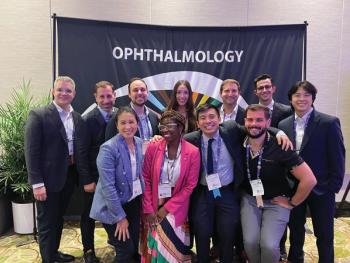
Data promising in uveitic macular edema pivotal trial
Novel local corticosteroid therapy shows positive efficacy signals, favorable safety profile says Rahul Khurana, MD.
The positive efficacy signals and the favorable safety profile of a novel local corticosteroid treatment suggest it has benefit for patients with macular edema due to noninfectious uveitis.
PEACHTREE-a phase III study of suprachoroidal injection with a proprietary formulation of triamcinolone acetonide (CLS-TA, Clearside Biomedical) for the treatment of macular edema due to noninfectious uveitis-met its primary efficacy endpoint and found a favorable safety profile for the investigational agent, said Rahul Khurana, MD.
The study is the first uveitis trial to assess improvement in visual acuity rather than vitreous haze as its primary endpoint, said Dr. Khurana, partner, Northern California Retina Vitreous Associates, Mountain View, CA, and clinical associate professor of ophthalmology, UCSF Medical Center, San Francisco.
The results at the end of the 6-month study showed that compared with sham injection, the percentage of patients gaining ≥15 ETDRS letters from baseline was significantly greater in the group receiving suprachoroidal CLS-TA than in the sham injection control arm (46.9% versus 15.6%).
Analyses of mean change from baseline best-corrected visual acuity (BCVA), mean change in central subfield thickness (CST), resolution of macular edema, and improvement of uveitic inflammation also favored the CLS-TA arm.
The safety review showed no significant adverse events were associated with this new type of injection, and there were low rates of IOP and cataract in the CLS-TA arm.
“Macular edema is a leading cause of vision loss in uveitis, and its most challenging aspect is that it often persists despite adequate control of uveitis itself,” Dr. Khurana explained.
“The positive efficacy signals and the favorable safety profile of CLS-TA suggest it has benefit for patients with uveitic macular edema associated, which is a complex and often challenging condition.”
The suprachoroidal injection was developed in a collaboration among researchers at Emory University, Georgia Tech, and Clearside Biomedical. It utilizes a 30-gauge needle of <1,000 μm in length to access the suprachoroidal space.
“Animal data show that suprachoroidal injection of triamcinolone leads to higher amount of the drug in the choroid, retinal pigment epithelium, and retina with much lower exposure in the anterior segment compared with intravitreal injections,” he said.
“Thus, the suprachoroidal injection has great potential for increased efficacy and better safety than intravitreal treatment.”
Study design
PEACHTREE enrolled patients with macular edema secondary to uveitis in any anatomic location who had a central subfield thickness (CST) ≥300 μm and BCVA ranging from 20/800 to 20/40. Patients with IOP >22 mm Hg or uncontrolled glaucoma were excluded, but patients with IOP <22 mm Hg were eligible, even if they were on up to two IOP-lowering medications.
In this multicenter double-masked study, a total of 160 patients were randomly assigned 3:2 to receive suprachoroidal CLS-TA 4.0 mg or sham injection at baseline and week 12. At week 4, patients were eligible for rescue therapy.
The two groups were balanced at baseline with respect to demographic characteristics, mean BCVA (Snellen equivalent ~20/80), mean CST (~500 μm), and uveitic anatomic subtypes.
More efficacy data
Mean visual acuity improvement from baseline to month 6 was 13.8 letters in the CLS-TA
arm versus 3.0 letters in the control group. The treatment benefit was seen as early as week 4 in the CLS-TA arm, persisted throughout the study, and was consistent across all uveitic anatomic location subgroups.
Dr. Khurana noted that CST decreased by a mean of 153 μm in the CLS-TA arm versus 18 μm in the control arm. The anatomic response also was seen by week 4 and consistent across all uveitic subtype groups.
More than 50% of CLS-TA patients achieved resolution of macular edema defined as CST > 300 μm, compared with only 14% of control patients, and more than two-thirds of patients treated with CLS-TA had improvement in uveitic inflammation. Rescue therapy was received by 72% of control patients at a median of 36 days versus by 13% of patients treated with CLS-TA at a median of 89 days.
Elevated IOP adverse events were more common in the control arm than the CLS-TA arm (15.6% versus 11.5%), which Dr. Khurana said was explained by the higher rate of rescue treatment in the control arm.
Rates of IOP elevation ≥10 mm Hg, IOP ≥30 mm Hg, and treatment with IOP-lowering medication were also lower in the CLS-TA arm compared with controls. No patients required surgery for IOP control.
The rate of cataract adverse events was 7.3% in the CLS-TA arm and 6.3% in the control arm. There were no cataract-related surgeries.
“It is important to remember that this was a 6-month study and cataract takes longer to develop,” Dr. Khurana said.
Disclosures:
Rahul Khurana, MD
E: rnkhurana@gmail.com
This article was adapted from Dr. Khurana’s presentation at the 2018 meeting of the American Academy of Ophthalmology. Dr. Khurana receives grant support from Clearside Biomedical.
Newsletter
Keep your retina practice on the forefront—subscribe for expert analysis and emerging trends in retinal disease management.




